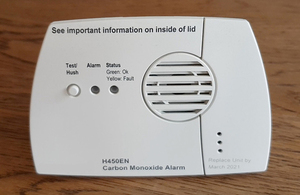Carbon monoxide detector
Carbon monoxide (CO) is a colourless, tasteless and odourless gas that is highly poisonous. It can cause serious damage to health if inhaled over a long period, and can quickly cause neurological damage, paralysis or death.
Carbon monoxide is produced when a combustion appliance such as a boiler, heater, oven, and so on, does not completely burn a carbon-based fuel. This might include fuels such as; gas, oil, paraffin, coal, wood or charcoal. Typically, fuel might not be completely burned if an appliance has been incorrectly installed or maintained or if vents, chimneys or flues are blocked. It may also enter a property through shared chimneys or flues.
If a building is powered entirely by electricity, a carbon monoxide detector is not necessary, but there should be one in every room in a building where there is a fuel-burning boiler, fire, or stove.
Because carbon monoxide is colourless, tasteless and odourless, people may not notice it, but it can be detected by a carbon monoxide detector. Typically, an audible alarm is sounded if carbon monoxide is detected.
There are several different types of carbon monoxide detectors/alarms:
- A standalone unit
- A combined unit that also operates as a smoke detector.
- Sealed battery: Batteries are sealed inside the detector and an alarm sounds when they run out.
- Replaceable battery: Batteries will need replacing every 2-3 years.
- Smart detector: Alerts the occupant via their smartphone as well as triggering the alarm.
- Patch: This is a cheaper option which changes colour if there is carbon monoxide in the atmosphere, however, this is less safe as it does not sound an alarm.
Detectors should have a EN 50291 mark and a British Standards' Kitemark (or equivalent European mark). They should be installed in accordance with manufacturers’ instructions, typically at head height in each room with a combustion appliance. They should be tested regularly, and batteries replaced as required.
Since 2010, the building regulations have required that carbon monoxide alarms are installed in properties where a replacement, or new fixed solid fuel burning appliance is installed.
In 2015, the government introduced new regulations requiring private rented sector landlords in England to instal a carbon monoxide alarm in any room used as living accommodation where solid fuel is used. Detectors must be tested at the start of each tenancy, and penalties for failure to comply can be up to £5,000.
[edit] 2018 review
In April 2018, the Government announced it was undertaking a review of rules that require carbon monoxide alarms to be fitted in homes across England when solid fuel appliances such as wood burning stoves and boilers are installed. The review will examine the regulations to establish whether they remain fit for purpose and will consider new research into the number of carbon monoxide poisonings and whether the rate of installation is being affected by the cost of alarms. (Ref. https://www.gov.uk/government/news/government-to-launch-review-into-carbon-monoxide-alarms)
[edit] Related articles on Designing Buildings Wiki
- BS EN 50291.
- Carbon monoxide
- Carbon monoxide Requirement J3.
- Combustion appliance.
- Fire detection and alarm system.
- Gas Safe.
- Glass break detector.
- Heat alarm.
- Homes (Fitness for Human Habitation) Act 2018.
- Interlinked fire alarm safety laws in Scotland.
- Intruder alarm.
- Ionisation smoke alarm.
- Mains gas.
- Multi-sensor alarm.
- Over £1 billion lost every year due to false alarms.
- Smoke damper.
- Smoke detector.
- Types of domestic boiler.
Featured articles and news
CIOB report; a blueprint for SDGs and the built environment
Pairing the Sustainable Development Goals with projects.
Latest Build UK Building Safety Regime explainer published
Key elements in one short, now updated document.
UKGBC launch the UK Climate Resilience Roadmap
First guidance of its kind on direct climate impacts for the built environment and how it can adapt.
CLC Health, Safety and Wellbeing Strategy 2025
Launched by the Minister for Industry to look at fatalities on site, improving mental health and other issues.
One of the most impressive Victorian architects. Book review.
Common Assessment Standard now with building safety
New CAS update now includes mandatory building safety questions.
RTPI leader to become new CIOB Chief Executive Officer
Dr Victoria Hills MRTPI, FICE to take over after Caroline Gumble’s departure.
Social and affordable housing, a long term plan for delivery
The “Delivering a Decade of Renewal for Social and Affordable Housing” strategy sets out future path.
A change to adoptive architecture
Effects of global weather warming on architectural detailing, material choice and human interaction.
The proposed publicly owned and backed subsidiary of Homes England, to facilitate new homes.
How big is the problem and what can we do to mitigate the effects?
Overheating guidance and tools for building designers
A number of cool guides to help with the heat.
The UK's Modern Industrial Strategy: A 10 year plan
Previous consultation criticism, current key elements and general support with some persisting reservations.
Building Safety Regulator reforms
New roles, new staff and a new fast track service pave the way for a single construction regulator.
Architectural Technologist CPDs and Communications
CIAT CPD… and how you can do it!
Cooling centres and cool spaces
Managing extreme heat in cities by directing the public to places for heat stress relief and water sources.
Winter gardens: A brief history and warm variations
Extending the season with glass in different forms and terms.
Restoring Great Yarmouth's Winter Gardens
Transforming one of the least sustainable constructions imaginable.
























